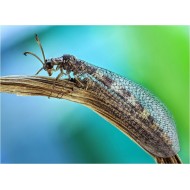The insect order Neuroptera, or net-winged insects, includes the lacewings, mantidflies, antlions, and their relatives. The order contains about 6,000 species.. Within the endopterygotes, the closest living relatives of the neuropteridan clade are the beetles. The common name lacewings is often used for the most widely known net-winged insects –...
The insect order Neuroptera, or net-winged insects, includes the lacewings, mantidflies, antlions, and their relatives. The order contains about 6,000 species.. Within the endopterygotes, the closest living relatives of the neuropteridan clade are the beetles. The common name lacewings is often used for the most widely known net-winged insects – the green lacewings (Chrysopidae) – but actually most members of the Neuroptera are referred to as some sort of "lacewing".
The adults of this order possess four membranous wings, with the forewings and hindwings about the same size, and with many veins. They have chewing mouthparts, and undergo complete metamorphosis
Neuropterans first appeared during the Permian period, and continued to diversify through the Mesoziod Era .During this time, several unusually large forms evolved, especially in the extinct family Kalligrammatidae, often referred to as "the butterflies of the Jurassic" due to their large, patterned wings.
